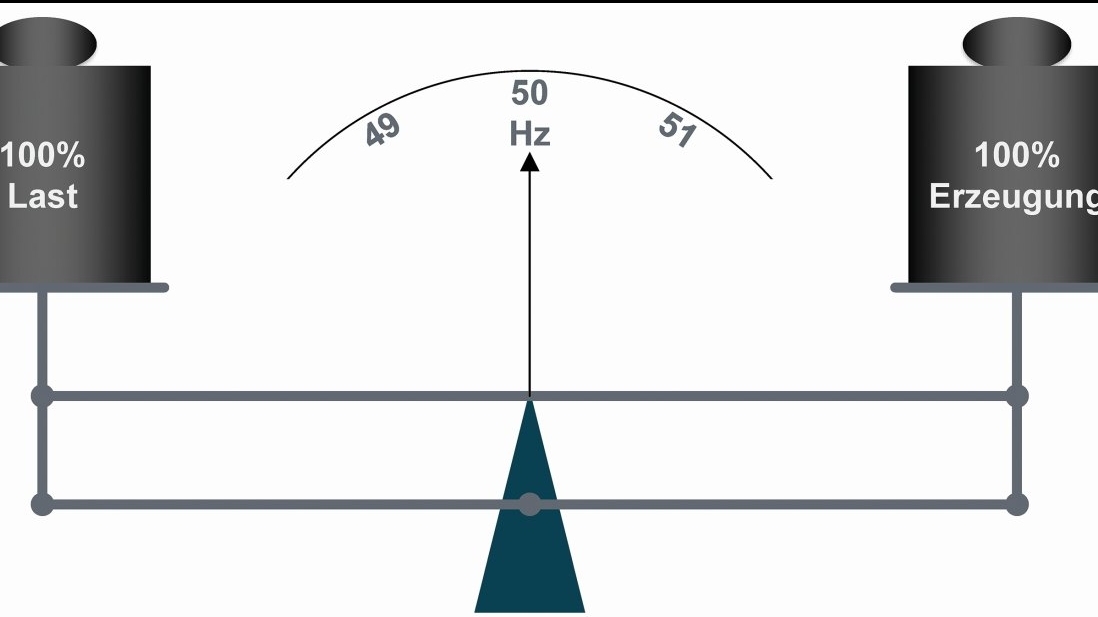Electrical energy is the only product that always has to be generated at the same moment it is consumed. Nevertheless, it is always available in full - whether it is used or not. How does this work? Can electroplating systems help to keep it that way
An electricity grid behaves like the so-called "equal-armed beam balance" in physics lessons (Fig. 1): This must always be in equilibrium. However, if there is a weight - or rather a mass - of 1 kg on the left-hand pan in the morning and 1 kg on the right-hand pan in the afternoon, there can be no question of equilibrium. Only if there is 1 kg on the left and 1 kg on the right pan at the same time is there balance. However, if the weights on the left and right scales differ by just one gram - i.e. one per thousand - the scales will move to their respective stops within a second or, if possible, a few seconds.
A power grid behaves in exactly the same way: the rotating mass of the generator in a large power station contains approximately as much energy as the generator feeds into the grid in one second. If this ratio applies to a single generator and its output, it also applies, as a first approximation, to the total output fed into the grid and the sum of the inertial masses of all generators feeding into this grid: One second without drive - and all generators would stand still. There is no more energy stored in the grid!
Together we are strong
This can only be handled by a perfect example of international cooperation - first of all from a technical point of view, in that an extremely large number of machines work extremely closely together, even though they are widely separated across an area covering almost the whole of Europe. All of the generators in the large generation plants are synchronous machines. This means that they all run synchronously with each other. This means that their speeds are in an absolutely rigid relationship to each other at all times, as if the individual machines were coupled via gear wheels, cardan shafts and chains.
Of course, the total power drawn from the system (plus its internal power loss - in Germany only around 4.6 percent from the power station to the customer's meter point) and the total drive power must be "in balance" at all times (Fig. 1). Consumers place loads on the load side at will at any time of day or night and also take them away again spontaneously. Producers, on the other hand, have to constantly agree at lightning speed who will place how much where and when so that the system remains in balance. The fact is that the frequency would be "at the limit" in a matter of seconds in the event of an imbalance in the order of 1 per thousand, which means that shutdowns would then occur. However, this does not happen if one of the large drive machines suddenly and unexpectedly "stops" - which does happen, as nothing is perfect in technology.
It can also happen, for example, that a large substation "goes bye-bye". Normally, these always have at least two transformers, one of which can carry the entire load alone if one suffers a defect or has to be switched off for maintenance work, but the switches and other equipment used for this purpose can also malfunction or be operated incorrectly, so that a medium-sized city or significant parts of a large city go dark in one fell swoop, i.e. suddenly cease to be a load.
In order for the technology to function over such a large area and yet so closely meshed, the people involved must also work closely together throughout Europe. To this end, the UCPTE [3] was founded in 1951 - initially only between Germany, France and Switzerland - to operate the first interconnected grid. In 1991, grid operation was split off from generation and only the UCTE [4] remained. Even more than that: for the same reason, it was dissolved again in 2009 andmergedwith 4 other interconnected grid companies(Fig. 2) to form ENTSO-E [5](Fig. 3).Their aim is to prevent unfavorable incidents from turning into a large-scale total outage. Not a single customer should have to be disconnected from the supply for even a single second as a result.
The UCTE once set itself the goal of creating a grid that could cope with the spontaneous, unforeseen loss of no less than 3 GW (3 gigawatts = 3 billion watts) of power plant capacity without interrupting the supply to any customers. This remains the case even after the merger, and although the UCTE no longer exists as an organization, it is still correct to speak of the
UCTE grid, as it still physically exists as a single, synchronously operating grid, which is, however, divided into control areas. Germany, for example, comprises 4 control areas, which in principle correspond to the supply areas of the 4 large transmission grid operators 50Hertz, Amprion, TransnetBW and Tennet TSO. A control area is characterized by the fact that the power flow at all of its interconnection points to neighbouring control areas is constantly measured, i.e. it is known at all times - even in total - and is normally kept at 0 on average over the course of a day.
-continued-


![Abb. 2: Diese 5 Netzbetreiber-Gesellschaften …[1] Abb. 2: Diese 5 Netzbetreiber-Gesellschaften …[1]](/images/stories/Abo-2020-10/thumbnails/thumb_gt-2020-10-0179.jpg)
![Abb. 3: … bildeten die ENTSO-E [2] Abb. 3: … bildeten die ENTSO-E [2]](/images/stories/Abo-2020-10/thumbnails/thumb_gt-2020-10-0180.jpg)
